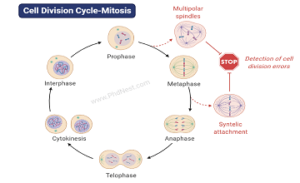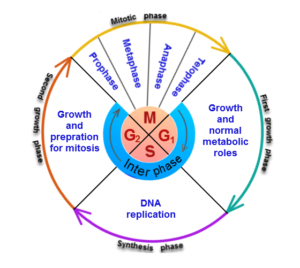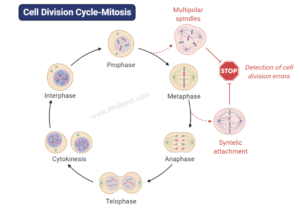What is Cell Cycle?
The cell cycle was discovered by Prevost and Dumas (1824) while studying the cleavage of zygote of Frog. It is a series of stages a cell passes through, to divide and produce new cells.
This entire process where with the help of one single parent cell a new cell population grows and develops is known as the cell cycle.
“Cell cycle refers to the series of events that take place in a cell, resulting in the duplication of DNA and division of cytoplasm and organelles to produce two daughter cells.”
- A sequence of cell events by which a cell duplicated its genome, synthesizes other constituents of cell & eventually divided into 2 daughter cells.
- Although cell growth is a continuous process, DNA synthesis occurs during 1 stage only.
Phases of Cell cycle-
Cell cycle or cell division refers to the series of events that take place in a cell leading to its maturity and subsequent division. These events include duplication of its genome and synthesis of the cell organelles followed by division of the cytoplasm.
Human cells exhibit typical eukaryotic cell cycle and take around 24 hours to complete one cycle of growth and division. The duration of the cycle, however, varies from organism to organism and cell to cell.
- A cell divides approx. Every 24 hours.
- For Yeast, it’s 90 minutes. It is divided into 2-
Click Here for Complete Biology Notes
Interphase –
- The phase between 2 successive M phases lasts for more than 95% of the duration of the cell cycle. Also called the resting phase. Cell prepares for division by undergoing cell growth and DNA replication.
M phase –
- When actual cell division occurs, it starts with nuclear division, separation of daughter chromosome (Karyokinesis) and ends with division of cytoplasm(cytokinesis).
- G1 phase – Interval between mitosis and initiation of DNA replication. A cell is metabolically active but doesn’t replicate DNA. (2-5 hours). Some cells do not exhibit division (Heart cells). The cells that do not divide further exit the G1 phase to enter the inactive stage – quiescent stage(G0).
- S phase – (synthesis) DNA synthesis & replication takes place. DNA doubles but no increase in chromosome number. In animal cells, during S- phase, DNA replication begins in the nucleus and centriole duplicates in the cytoplasm. 2nà4n (Tetraploid). (6-12 hours)
- G2 phase – Proteins are synthesizing for cell division, cell organelle duplicates. In animal cells, a mitotic division is in a diploid cell only but in plants. It’s in both haploid and diploid. (2-6 hours).
- Diploid daughter cell. (Somatic cell)
- A chromosome is parent and progeny cell are same so-called equational division.
Prophase –
- Initiation of condensation of chromosomal material.
- Centrosome starts to move towards opposite poles and radiates microtubules called asters.
- Nuclear membrane, cell organelle disappears.
Metaphase –
- Chromosomes are moved to the spindle equator and get aligned along with the metaphase plate through spindle fibres to both poles—a plane of alignment of chromosome – Metaphase plate.
- Complete disintegration of nuclear envelope, condensation of chromosomes.
- Kinetochore (Disc-shaped structure at centromere) are a site of attachment of spindle fibres.
- Morphology of chromosome is situated.
Anaphase –
- Centromere split, chromatid separate, chromatid move to the opposite pole.
- Chromatin material is reduced to half, but chromosome numbers remain the same.
Telophase –
- Chromosome cluster at opposite spindle poles, and there is lost as discrete elements; nuclear envelope, nucleolus, cell organelle reappears.
Cytokinesis –
- Animal cell- appearance of furrow in plasma membrane which depends and joins in centre dividing cytoplasm into two.
- Plant cell wall formation starts in the centre and grows outward to meet lateral walls. This leads to the formation of a new cell wall. I.e., Cell plate, which represents the middle lamella between cells.
- In some cases, Karyokinesis is not followed by cytokinesis; as a result, multinucleate conditions arise, leading to the formation of syncytium (E.g., Liquid Endosperm in coconut)
Significance of Mitosis-
- Growth of multicellular and for a cell to restore nucleo- cytoplasmic ratio.
- Helps in growth of plants by division of meristematic tissues.
- Helps in cell repair.
Meiosis –
- Haploid daughter cell. (Reproductive cell)
- Chromosome number is reduced to half, so-called reductional division.
- Two sequential cycles of nuclear & cell division – Meiosis I & Meiosis II but a single cycle of DNA replication.
- Involves pairing of homologous chromosomes, recombination between non- sister chromosome of homologous chromosomes.
Meiosis I
Prophase I – Typically longer. The nuclear membrane starts disappearing. Centriole duplicate itself; Cell organelle start disappearing, and astral fibre arises. Centriole migrates to opposite poles.
- Leptotene – Condensation of chromatin material to form chromosome.
- Zygotene – Pairing of homologous chromosomes – synapsis. Synaptonemal complex develops by synapsed chromosome called bivalent or tetrad.
- Pachytene – Appearance of recombination nodule where crossing over between non-sister chromatids takes place. Crossing over is an exchange of genetic material between homologous chromosomes by enzyme recombinase.
- Diplotene – Dissolution of the synaptonemal complex, non-sister chromatid starts to separate from each other except the side of the crossover. It forms X shaped structure- chiasmata. In oocytes, it can last for a month or years.
- Diakinesis – Terminalization of chiasmata, the chromosome is fully condensing, meiotic spindle to assembled, nucleolus disappear, nuclear envelope breaks.
Metaphase I – Bivalent chromosome align at equatorial plate—spindle fibre attack to the kinetochore.
Anaphase – Homologous chromosome separate, sister chromatid remains associated at the centromere.
Telophase I – Nucleolus and nuclear membrane reappear, cytokinesis follows and is called as a dyad of cells.
Interkinesis – Stage between 2 meiotic divisions, short-lived, no replication of DNA.
Meiosis II
Prophase II – Nuclear membrane disappear, chromosome become compact.
Metaphase II – Chromosome align at the equator; spindle fibre gets attached to the kinetochore.
Anaphase II – Splitting of the centromere of each chromosome, move towards opposite poles and shortening of the microtubule.
Telophase II – Nuclear envelope reappear, cytokinesis follows the formation of a tetrad of cells; 4 haploid daughter cells.
Significance of meiosis – Increase genetic variability.
Related Posts
- Phylum Porifera: Classification, Characteristics, Examples
- Dissecting Microscope (Stereo Microscope) Definition, Principle, Uses, Parts
- Epithelial Tissue Vs Connective Tissue: Definition, 16+ Differences, Examples
- 29+ Differences Between Arteries and Veins
- 31+ Differences Between DNA and RNA (DNA vs RNA)
- Eukaryotic Cells: Definition, Parts, Structure, Examples
- Centrifugal Force: Definition, Principle, Formula, Examples
- Asexual Vs Sexual Reproduction: Overview, 18+ Differences, Examples
- Glandular Epithelium: Location, Structure, Functions, Examples
- 25+ Differences between Invertebrates and Vertebrates
- Lineweaver–Burk Plot
- Cilia and Flagella: Definition, Structure, Functions and Diagram
- P-value: Definition, Formula, Table and Calculation
- Nucleosome Model of Chromosome
- Northern Blot: Overview, Principle, Procedure and Results


















